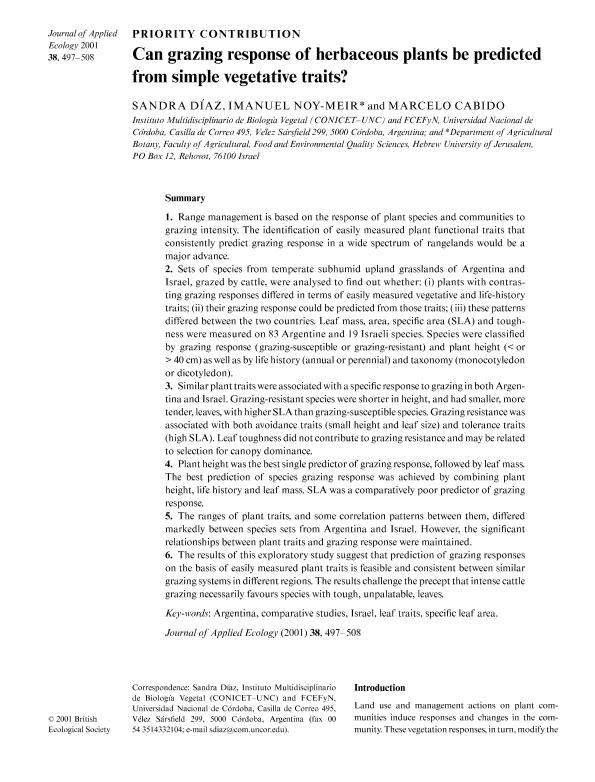Artículo
Can grazing response of herbaceous plants be predicted from simple vegetative traits?
Fecha de publicación:
07/2001
Editorial:
Wiley Blackwell Publishing, Inc
Revista:
Journal of Applied Ecology
ISSN:
0021-8901
e-ISSN:
1365-2664
Idioma:
Inglés
Tipo de recurso:
Artículo publicado
Clasificación temática:
Resumen
Range manafement is based on the response of plant species and communities to grazing intensity. The identification of easily measured plant functional traits that consistently predict grazin response in a wide spectrum of rangelands would be major advance. Sets of species from temperate subhumid upland grasslands of Argentina and Israel, grazed by cattle, wer analised. Similar plant traits were associated with a specific response to grazing in both Argentina and Israel. Grazing resistant species were shorter in height, and had smaller, more tender leaves, with higher SLA than grazing susceptible species. Plant height was the best sigle predictor of grazing response, followed by leaf mass. The best prediction of species grazing response was acchieved by combining plant height, life istory and leaf mass. SLA was a comparatively poor predictor of grazing response.<br />5- The ranges of plant traits, and some correlation patterns between them, differed markedly between species sets from Argentina and Israel, However, the significant relationships be4tween plant traits and grazing response were mainteined. The results of this exploratory study suggest that preciction of grazing responses on the basis of easily measured plants traits is feasible and consistent between similar grazing systems in different regions. The results challenge the precept that intense cattle grazing necessarily favours species with tough, unpalatable leaves.
Palabras clave:
Argentina
,
Comparative Studies
,
Israel
,
Leaf Traits
,
Specif Leaf Areas
Archivos asociados
Licencia
Identificadores
Colecciones
Articulos(IMBIV)
Articulos de INST.MULTIDISCIPL.DE BIOLOGIA VEGETAL (P)
Articulos de INST.MULTIDISCIPL.DE BIOLOGIA VEGETAL (P)
Citación
Díaz, Sandra Myrna; Noy Meir, Imanuel; Cabido, Marcelo Ruben; Can grazing response of herbaceous plants be predicted from simple vegetative traits?; Wiley Blackwell Publishing, Inc; Journal of Applied Ecology; 38; 3; 7-2001; 497-508
Compartir
Altmétricas




